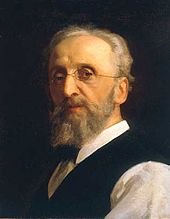Antonio Ciseri

Antonio Ciseri (born October 25, 1821 in Ronco sopra Ascona , † March 8, 1891 in Florence ) was a Swiss-Italian painter .
Life
Ciseri was born in Ticino as the son of Giovan Francesco Ciseri and Caterina Materni . His father and grandfather had been decorative painters in Tuscany for generations . In 1833 he moved to his father in Florence, where he first worked in the studio of the painter Ernesto Buonaiuti and then studied with Niccola and Pietro Benvenuti and Giuseppe Bezzuoli at the Accademia di Belle Arti Benvenuti . His religious motifs are raffaelesque in their composition and have a plastic representation. Since then he has had a lifelong friendship with the sculptor Giovanni Dupré .
Ciseri made a number of commissioned works for Italian and Swiss churches. He also painted a large number of portraits , e.g. B. by Gaetano Bianchini (gift to his father-in-law).
In 1853 he opened his own painting school. His students included Silvestro Lega (1826–1895), Niccolò Cannicci (1846–1906), Girolamo Nerli (1860–1926), Raffaello Sorbi (1844–1931) and Giacomo Martinetti from Ticino , who later became his assistant. Egisto Sarri (1837–1901) is considered to be his best student. The private school was officially recognized in 1860.
In 1852 Ciseri was appointed professor of higher education at the Florence Academy. In 1855 he married Cesira Bianchini, the daughter of the mosaic painter Gaetano Bianchini. In 1868 he became a member of the Supreme Council for Education of the Italian State (Consiglio superiore della pubblica istruzione). From 1874 to 1875 he was temporarily director of the academy.
Due to high Ticino tax demands, Ciseri became an Italian citizen at his request in 1877 and renounced his Swiss citizenship. However, he remained connected to Ticino and was a member of the cantonal commission for the reorganization of drawing lessons in Ticino schools.
Ciseri died 70 years old and has been in the Florentine church of San Miniato al Monte buried
Works
- The departure of Giano della Bella into voluntary exile (La partenza di Giano della Bella per il volontario esilio) made his appointment to the academy possible
- Martyrdom of the Maccabees in the church of Santa Felicità in Florence (1853–63), for which he was awarded the gold medal at the World Exhibition in Vienna in 1873, is his most famous work
- He painted the Entombment of Christ (Il trasporto di Cristo al sepolcro) in 1883 in the pilgrimage church of Madonna del Sasso in Orselina on behalf of the lawyer Bartolomeo Rusca
- Ecce homo was commissioned for the Italian government
literature
- Letizia Schubiger-Serandrei: Antonio Ciseri. In: Historical Lexicon of Switzerland . December 6, 2002 , accessed December 5, 2019 .
Web links
- Maria Fazioli Foletti: Antonio Ciseri. In: Sikart
- Antonio Ciseri painter (Italian) on ti.ch/can/oltreconfiniti
Individual evidence
- ↑ a b c d e f g h i j Giulio Foletti, et al .: Anchor to Zünd - Art in the Young Federal State 1848–1900 . Ed .: Christian Klemm. Scheidegger & Spiess / Kunsthaus Zürich, Zürich 1998, ISBN 3-906574-00-8 , p. 398 .
- ^ A b Eduard Platzhoff: Antonio Ciseri. Retrieved February 4, 2020 .
- ^ Ciseri, Antonio . In: Ulrich Thieme (Hrsg.): General Lexicon of Fine Artists from Antiquity to the Present . Founded by Ulrich Thieme and Felix Becker . tape 7 : Cioffi – Cousyns . EA Seemann, Leipzig 1912, p. 13 ( Textarchiv - Internet Archive ).
| personal data | |
|---|---|
| SURNAME | Ciseri, Antonio |
| BRIEF DESCRIPTION | Swiss-Italian painter |
| DATE OF BIRTH | October 25, 1821 |
| PLACE OF BIRTH | Ronco sopra Ascona |
| DATE OF DEATH | March 8, 1891 |
| Place of death | Florence |

